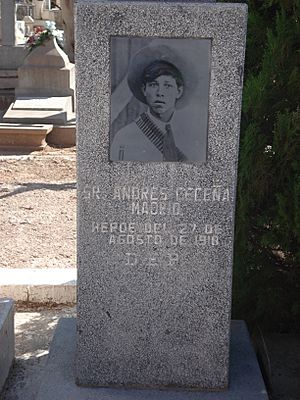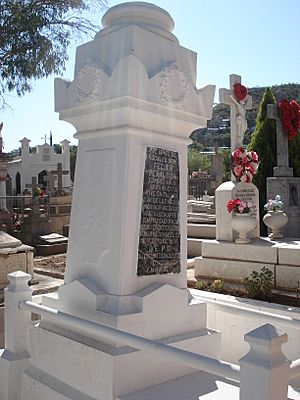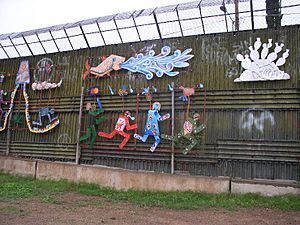Battle of Ambos Nogales facts for kids
Quick facts for kids Battle of Ambos Nogales |
|||||||
|---|---|---|---|---|---|---|---|
| Part of the Mexican Revolution, World War I, Border War | |||||||
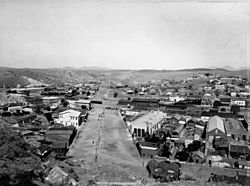 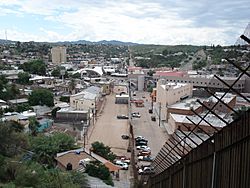 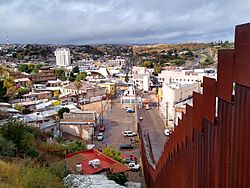 The U.S.-Mexico border in Nogales in 1898, 2008 (pre-2011 wall), and 2021. International Street/Calle Internacional runs through the center of the image between Nogales, Sonora (left), and Nogales, Arizona (right). Note border posts without fence and rail line in 1898. Customs Post where the first shooting occurred is in center of image this side of rail line. Click on image to enlarge. |
|||||||
|
|||||||
| Belligerents | |||||||
Alleged: |
|||||||
| Commanders and leaders | |||||||
| Unknown | |||||||
| Strength | |||||||
| ~800 | Unknown | ||||||
| Casualties and losses | |||||||
| 5 U.S. soldiers and 2 civilians killed 28 U.S. soldiers and several civilians wounded |
Mexico: Up to 28-30 Mexican soldiers and about 100 civilians killed; 129 new graves were counted About 300 total wounded Alleged: 2 German soldiers killed |
||||||
The Battle of Ambos Nogales (meaning "The Battle of Both Nogales") was a fight on August 27, 1918. It happened between Mexican soldiers and armed citizens, and U.S. Army troops. The U.S. soldiers were from the 35th Infantry Regiment and the Buffalo Soldiers of the 10th Cavalry Regiment.
The battle took place in Nogales, Arizona, and Nogales, Sonora. It was a major clash between U.S. and Mexican forces during the Border War. This conflict was part of the larger Mexican Revolution and First World War.
Before 1910, the border between the two Nogales cities was an open street. But during the 1910s, violence from the Mexican Revolution and fears about World War I led to stricter U.S. border control. Anti-foreign feelings grew, especially after the Zimmermann Telegram was revealed in 1917. This telegram showed Germany trying to get Mexico to join the war against the U.S.
Shootings of Mexican people by U.S. soldiers at the border also increased tensions. After the battle, the U.S. and Mexico agreed to build a fence. This was the first permanent border wall between the two cities.
Contents
Background to the Battle
Tensions on the U.S.-Mexico Border
The Mexican Revolution started in 1910. It caused a decade of intense fighting along the U.S.-Mexico border. Different groups in Mexico fought for power. Towns like Nogales, Sonora, were important because they offered access to weapons and customs money.
Battles for control of Mexican Nogales often caused shooting across the border into the U.S. This happened during the Battle of Nogales (1913) and again in 1915. In 1915, a U.S. soldier was killed by a stray bullet.
After this, Mexican revolutionary leader Pancho Villa attacked Columbus, New Mexico. U.S. President Woodrow Wilson then sent General John J. Pershing and the Punitive Expedition into Mexico. Their goal was to find Villa. This mission led to more border tensions.
U.S. Soldiers and World War I

The U.S. entered World War I in April 1917. The 10th Cavalry, known as the "Buffalo Soldiers," was stationed near Nogales, Arizona. This unit had experience from the Punitive Expedition. Their presence showed the U.S. was serious about border security.
U.S. leaders also watched for German spies. The Zimmermann Telegram showed Germany wanted Mexico to fight the U.S. However, Mexico was weak from the Revolution. Its economy was struggling, and many Mexicans moved to the U.S. for food and work.
Border Rules and Local Anger
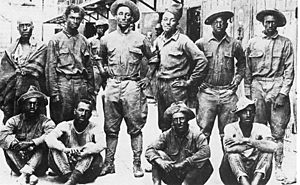
World War I led to strict new rules at the border. The U.S. limited what people could take into Mexico. They also made it harder for Mexicans to cross into the U.S. People needed passports and could only cross at certain points.
This was a big change for people in Ambos Nogales. They were used to moving freely between the two cities. These new rules caused a lot of anger. U.S. customs officials sometimes treated Mexicans harshly.
In late 1917 and early 1918, U.S. officials killed two unarmed Mexicans at the border. One was a Mexican customs agent, and the other was a deaf man. These killings made the people of Nogales, Sonora, very upset. They felt U.S. guards were acting without consequences.
Rumors of German Involvement
Some U.S. Army reports claimed Germans were helping the Mexican Army. Lt. Col. Frederick J. Herman, a U.S. commander in Nogales, said he got a letter. The letter warned of a Mexican attack on Nogales, possibly encouraged by Germans.
However, a U.S. military investigation after the battle found no proof of this letter or German involvement. The investigation concluded that the violence started because of the harsh treatment by U.S. customs officials. It also pointed to the anger caused by the earlier killings at the border.
The Battle Begins
On August 27, 1918, around 4:10 p.m., a fight started by accident. A Mexican carpenter named Zeferino Gil Lamadrid tried to cross back into Mexico. He was carrying a large package. A U.S. Customs Inspector told him to stop for inspection.
Mexican customs officers told him to ignore the U.S. order and stay in Mexico. Gil Lamadrid got confused. A U.S. soldier raised his rifle to make him return. A shot was fired, though it's unclear by whom. This started the Battle of Ambos Nogales.
Gil Lamadrid thought he was shot and fell. A Mexican customs officer, Francisco Gallegos, then shot and killed the U.S. soldier. The U.S. inspector shot back, killing Gallegos and another Mexican officer. Gil Lamadrid ran away and was not involved further.
Fighting Spreads Across the Border
Many Mexican citizens heard the gunfire. They grabbed their rifles and joined the fight. While some Mexican soldiers were involved, most of the fighters were civilians.
The U.S. 35th Infantry asked for help. Buffalo Soldiers from the 10th Cavalry arrived. Their commander, Lt. Col. Frederick Herman, ordered an attack into Nogales, Sonora. He wanted to take the Mexican hilltops that overlooked the border.
Mexican civilians used the sturdy stone walls of General Álvaro Obregón's home as a strongpoint. Obregón was not home, but his family was. They were safely escorted to relatives on the U.S. side.
U.S. troops crossed the border under heavy fire. Many women from both sides bravely helped the wounded. One American soldier received an award for saving civilians while wounded himself.
U.S. and Mexican reports differ on who controlled the hills. U.S. sources say their troops took the heights. Mexican stories say their townspeople stopped the U.S. attack. During the fighting, Captain Joseph D. Hungerford of the 10th Cavalry was killed.
Private James Flavian Lavery used his truck to carry supplies and wounded soldiers. He was awarded the Distinguished Service Cross for his bravery. American civilians also fired from their homes. A machine gun placed on a building by U.S. troops helped end the fighting.
Mayor Peñaloza's Death and Cease-fire
The Mayor of Nogales, Sonora, Felix B. Peñaloza, tried to stop the violence. He took a white handkerchief, tied it to his cane, and ran into the streets. He pleaded with his citizens to stop fighting.
Despite later U.S. claims, an official U.S. Consulate note confirmed that a shot "from the Arizona side" killed the mayor. Peñaloza died a short time later.
After the mayor's death, officials from both sides worked for a cease-fire. Around 7:45 p.m., the Mexicans raised a large white flag over their customs building. Lt. Col. Herman ordered an immediate cease-fire. Sporadic shooting continued for a while but eventually stopped. Many people in Nogales, Sonora, fled south. The border remained closed until the next day.
Aftermath of the Battle
Peace Talks and Investigations
Soon after the battle, leaders from both governments sent officials to investigate. Mexican President Carranza sent Governor Plutarco Elías Calles to represent Mexico. General DeRosey Cabell represented the U.S.
Cabell and Calles met and expressed regret for the incident. Calles said the remaining shooters were "irresponsible men." All civilians in Nogales, Sonora, were ordered to turn in their weapons.

General Cabell's investigation found that a U.S. customs inspector had acted improperly. The report blamed the violence on the resentment Mexicans felt from being mistreated by U.S. customs officials.
The Mexican Consul in Nogales also highlighted the abuse from U.S. officials. He said it caused the Mexican people to fight.
Casualties and Awards
The U.S. Army had 5 soldiers and 2 civilians killed. 28 soldiers and several civilians were wounded.
- Killed in action included Private William Klint, 2nd Lt. Luke Loftus, Corporal Barney Lots, Corporal Frank Whitworth, and Captain Joseph Hungerford.
Several U.S. soldiers were wounded, including Lt. Col. Frederick J. Herman.
- Private James Flavian Lavery earned a Distinguished Service Cross for saving wounded soldiers.
- Lieutenant Oliver Fannin also won a Distinguished Service Cross for carrying a wounded man to safety.
The exact number of Mexican casualties is unclear. U.S. reports suggested up to 125 killed and 300 wounded. The Mexican government reported 15 dead, including Mayor Felix B. Peñaloza and customs officers Francisco Gallegos and Andrés Ceceña. Among the Mexican dead were also young civilians like three-year-old Julia Medina.
No Proof of German Involvement
The U.S. government's investigation found that the battle was caused by local tensions. It was due to the poor treatment of Mexican people by U.S. Customs officials. There was no evidence of German involvement.
Despite this, some rumors continued. Lt. Col. Fred Herman later claimed that "German-looking men in uniforms" led the Mexican fighters. However, no documents or evidence support these claims. Oral histories from Nogales residents also did not mention German spies.
Legacy of the Battle
The Battle of Ambos Nogales is not well-known in the U.S. There are no monuments to it on the U.S. side.
In Mexico, the "Battle of August 27" is more remembered. A Mexican folk song, "El Corrido de Nogales," tells the story from the Mexican side. Nogales, Sonora, has a monument near the border to honor the Mexican participants and victims. The tombs of Mayor Peñaloza and other victims are kept in the city's Panteón de los Héroes (Heroes' Cemetery).
In 1961, the Mexican Congress honored the city. They gave Nogales, Sonora, the title "Heroic City" (Heróica Nogales). This is a special title shared with other Mexican cities that saw military conflicts.
The Border Fence
One of the most lasting results of the battle is the border fence. After the battle, General Cabell suggested building a two-mile-long fence. Governor Calles agreed.
This new fence was permanent. It changed the open nature of the border in Nogales forever. Even though families still had strong ties across the border, the fence clearly divided the community into two different cities in two different nations.
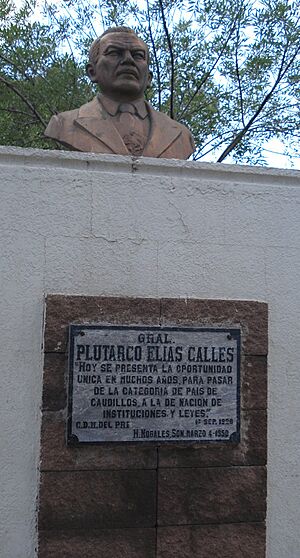
Images for kids
-
Historical marker on Calle Ruiz Cortines in Heróica Nogales, Sonora, indicating the place where Felix Peñaloza died on 27 August 1918.
-
American and Mexican soldiers guarding International Street in Ambos Nogales. The obelisk in the center is a border marker, which still stands. A Mexican border post is in the middle foreground of the image. The Americans had a similar one on their side.


